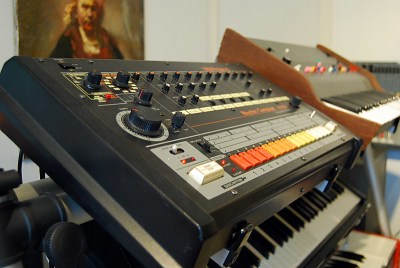
Roland's legendary drum machine does definitely not need any introduction. There is also a lot of very useful information sites about the TR-808, so there is no need for any detailed information either.
However, 808's are expensive and hard to come by. It does not either have any MIDI, so although you have one, it is not easy to integrate into a computer-based sequencer system. Still, sampling an 808 is not the same thing, as samples from the 808 tend to sound very lifeless and dull. The reason for this is that the 808 generates its sound by analogue oscillators through filters and envelopes. This means that each time a sound is triggered, it is generated and modified by various semi-conductors, and it will each time sound slightly different. If you look at the waveforms that the 808 generates using e.g. a wave editing software, you can actually see that the waveform looks very different each time it's generated, there are even differences in amplitude. That is one reason why the beats from a real 808 sounds much better than beats generated from singular samples of the 808. With a real 808 you can of course also adjust some sound parameters, like snare and tom pitch and cymbal decay, so this adds some more flexibility of the sound.
There is one way to capture the sound of an 808 better: instead of using only one sample of each sound, you can sample several hits of the same sound, and set your sampler to cycle through these samples, each time a sound is triggered. That is exactly what I have done from my 808. Unfortunately, not all samplers have this feature, but at least NI Battery 3 has this feature. So here it is: a multi-sampled 808, completely free of charge!
![]() Kebu's TR-808 samples, 24 bit WAV, 44 kHz
Kebu's TR-808 samples, 24 bit WAV, 44 kHz
![]() Kebu's TR-808 - NI Battery 3 kit
Kebu's TR-808 - NI Battery 3 kit
If you use the samples in your production, I'd be happy if you drop me an e-mail as thanks or acknowledge me in the notes of your production. Or you can just buy some of my records... :)
One more hint: the 808 also mixes the sound sources using analogue mixing for its output (unless you use the individual outputs). So to add a bit more realism, make sure you route each sound out through its own DA-converter and mix it using an analogue console!
Happy 808-ing!
![]()